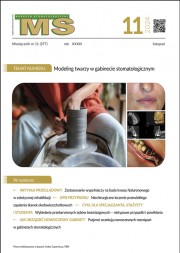Dostęp do tego artykułu jest płatny.
Zapraszamy do zakupu!
Cena: 6.15 PLN (z VAT)
Kup artykuł
Po dokonaniu zakupu artykuł w postaci pliku PDF prześlemy bezpośrednio pod twój adres e-mail.
The geriatric patient at the dental surgery. Part II. The problem of impacted teeth in old age
Grzegorz Trybek, Magda Aniko-Włodarczyk, Olga Preuss, Katarzyna Grocholewicz
Grzegorz Trybek, Magda Aniko-Włodarczyk, Olga Preuss, Katarzyna Grocholewicz
Streszczenie
Zęby zatrzymane u osób w podeszłym wieku stanowią duży problem diagnostyczno-leczniczy dla lekarza stomatologa i chirurga. Nieusunięte w okresie rozwoju, w zaawansowanym wieku często stają się przyczyną komplikacji. Do najczęściej wymienianych należą: obrzęk, problem z użytkowaniem protez ruchomych, zmiany patologiczne o charakterze torbieli czy nawet złamania w obrębie żuchwy.
Abstract
Impacted teeth in older people are a big problem for diagnosis/treatment for the dentist and for the surgeon. Teeth not removed during the developmental phase, in advanced age are often a source of complications. The most frequently named are: swelling, problems with use of dentures, pathological changes of a cystic nature or even fractures in the region of the mandible.
Hasła indeksowe: zęby zatrzymane, wiek podeszły
Key words: impacted teeth, elderly
PIŚMIENNICTWO
1. Grzesiak-Janas G., Janas A., Sikorska I.: Zęby zatrzymane. Mag. Stomatol., 2006, XVI, 3, 92-94.
2. Janas A.: Całkowicie zatrzymane zęby przedtrzonowe w materiale własnym. Por. Stomatol., 2010, 10, 1, 7-9.
3. Ratajek-Gruda M.: Ocena położenia dolnych trzecich zębów trzonowych na zdjęciach pantomograficznych w aspekcie przewidywania trudności w leczeniu. Rozprawa doktorska, UM Łódź 2003.
4. Sporniak-Tutak K., Sobczyk P., Malinowski J., Chruściel-Nogalska M.: Zęby zatrzymane – dlaczego je usuwamy? Quintessence dla lekarzy stom., 2000, 8, 151-153.
5. Peterson L.J. i wsp.: Chirurgia stomatologiczna i szczękowo-twarzowa. Wyd. Czelej, wyd. I, Lublin 2001.
6. Adeyemo W.: Do pathologies associated with impacted lower third molars justify prophylactic removal? A critical review of the literature. Oral Surg. Oral Med. Oral Pathol., 2006, 102, 448.
7. Weyant R.: No evidence to support removal of asymptomatic impacted third molars in adolescents or adults. J. Evid. Based Dent. Pract., 2007, 7, 108-109.
8. Hill C.M., Walker R.V.: Conservative, non-surgical management of patients presenting with impacted lower third molars: A 5-year study. Br. J. Oral Maxillofac. Surg., 2006, 44, 347-350.
9. Von Wowern N., Nielson H.O.: The fate of impacted lower third molars after the age of 20. A four-year clinical follow up. Int. J. Oral Maxillofac. Surg., 1989, 18, 277-280.
10. Venta I., Ylipaavalniemi P., Turtola L.: Long-term evaluation of estimates of need for third molar removal. J. Oral Maxillofac. Surg., 2000, 58, 288-291.
11. Kinard B., Dodson T.: Most patients with asymptomatic, disease-free third molar elect extraction over retention as their preferred treatment. J. Oral Maxillofac. Surg., 2010, 68, 2935-2942.
12. Kugelberg C.F. i wsp.: The influence of anatomical, pathophysiological and other factors on periodontal healing after impacted lower third molar surgery. A multiple regression analysis. J. Clin. Periodontol., 1991, 18, 1, 37-43.
13. Chuang S.K. i wsp.: Age as a risk for third molar surgery complications. J. Oral Maxillofac. Surg., 2007, 65, 1685-1692.
14. Phillips C. i wsp.: Risk factors associated with prolonged recovery and delayed healing after third molar surgery. J. Oral Maxillofac. Surg., 2003, 61, 1436-1448.
15. Rai S. i wsp: Moral and professional responsibility of oral physician toward geriatric patient with interdisciplinary management. The time to act is now! J. Midlife Health, 2011, 2, 1, 18-24.
16. Kunkel M. i wsp.: Severe third molar complications including death - lessons from 100 cases requiring hospitalization. J. Oral Maxillofac. Surg., 2007, 65, 9, 1700-1706.
17. Patel V., Moore S., Sproat C.: Coronectomy – oral surgery’s answer to modern day conservative dentistry. Br. Dent. J., 2010, 209, 111-114.
18. Howe G., Poynton H.G.: Prevention of damage to the inferior alveolar nerve during the evaluation of mandibular third molars. Br. Dent. J., 1960, 109, 355-363.
19. Knutsson K., Lysell L., Rohlin M.: Postoperative status after partial removal of the mandibular third molar. Swed. Dent. J., 1989, 13,15-22.
20. Leung Y.Y., Cheung L.K.: Safety of coronectomy versus excision of wisdom teeth: a randomized controlled trial. Oral Surg. Oral Med. Oral Pathol. Oral Radiol. Endod., 2009, 108, 821-827.
21. Freedman G.L.: Intentional partial odontectomy. J. Oral Maxillofac. Surg., 1997, 55, 524-526.
22. Dolanmaz D. i wsp.: A preferable technique for protecting the inferior alveolar nerve: coronectomy. J. Oral Maxillofac. Surg., 2009, 67,1234-1238.
23. O’Riordan B.C.: Coronectomy (intentional partial odontectomy of lower third molars). Oral Surg. Oral Med. Oral Pathol. Oral Radiol. Endod., 2004, 98, 274-280.
24. Pogrel M.A.: Coronectomy to prevent damage to the inferior alveolar nerve. Alpha Omegan, 2009, 102:, 61-67.
25. Sencimen M. i wsp.: Is endodontic treatment necessary during coronectomy procedure? J. Oral Maxillofac. Surg., 2010, 68, 10, 2385-2390.
26. Ahmed C., Wafae el W., Bouchra T.: Coronectomy of third molar: a reduced risk technique for inferior alveolar nerve damage. Dent update, 2011, 38, 4, 267-276.
27. Hadzik J.,Papiór P., Dominiak M.: Koronektomia jako alternatywa dla zabiegu ekstrakcji zęba trzeciego trzonowego w żuchwie – opis przypadku. Twój Przegl. Stomatol., 2014, 11, 65-69.













